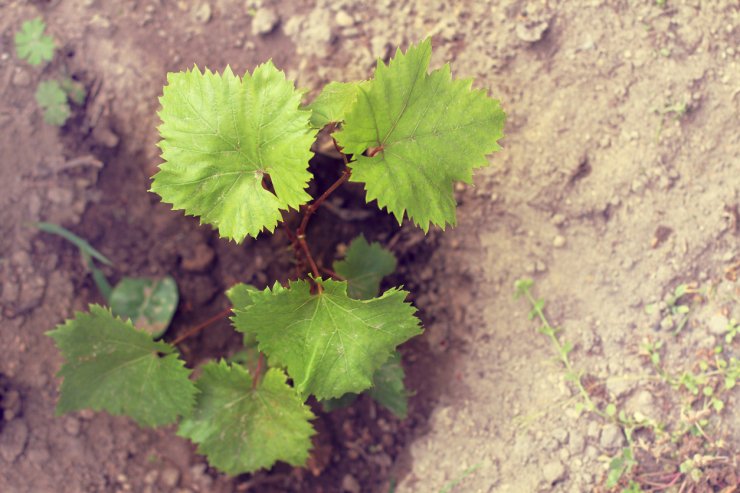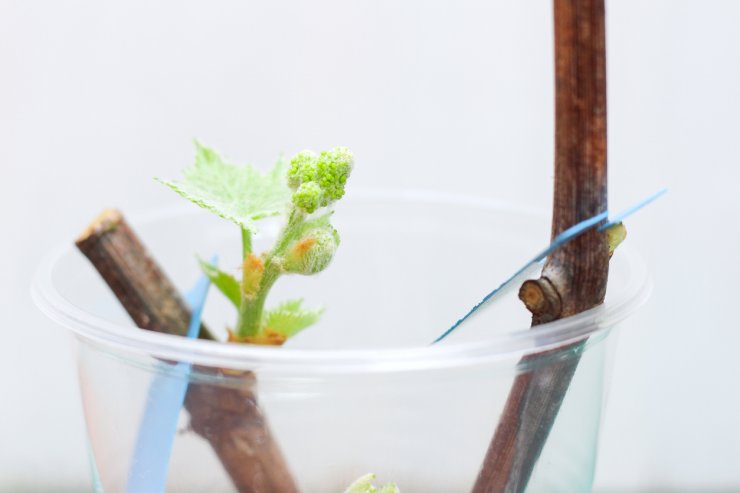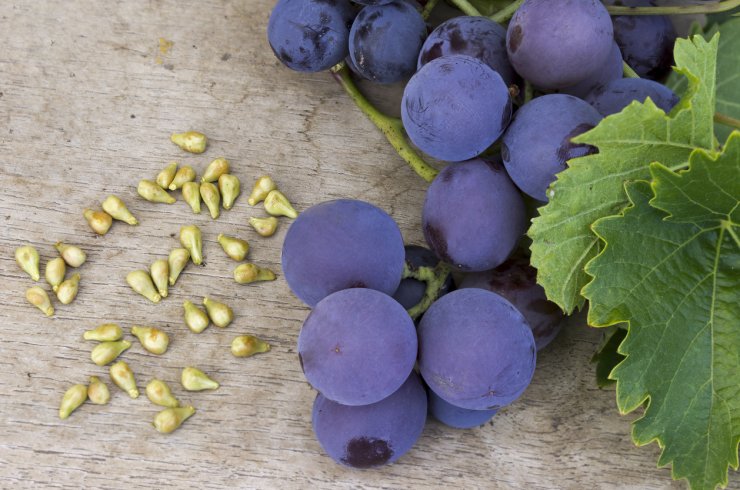
Young grape seedling.
Growing from vines
The easiest way to grow grape vines is to start with a plant from a nursery or remote retailer. If you order from catalogs or online sources, you’ll be getting dormant, bare-root plants. You should plant them as soon as possible.
You can also buy potted vines from a local nursery. While the timing is not as critical, because the roots are already growing, you should still get them into the ground promptly.
Make sure you purchase grape vines from a reputable nursery. Your best bet is a vigorous, 1-year-old plant. When it’s possible to check, buy certified virus-free stock. You may also see 2-year-old stock, which were held over by the nursery because they were too small and weak to sell in the first year.
Growing from cuttings

Grape vine cutting blossoming in nursery.
If you have access to a grape vine that’s a known good producer, you can also start from cuttings. Wait until the vine has gone dormant in the late fall or winter. Then, find some 6-foot-long, 1-year-old shoots, which will be a little bigger in diameter than a pencil.
Cut the shoots to about 12 to 18 inches long, each with four buds. Take more cuttings than you need, because some probably won’t grow. Measure from the lowest bud at the base of the shoot. Make sure you cut the base flat, and the top angled, so you’ll know which end is the base when it comes time to plant.
Dip the base of each cutting in rooting hormone, then insert the cuttings into the ground as soon as possible. Leave only one bud per cutting above the soil, and keep the soil moist. You should see growth on some of the cuttings the next spring. It will take up to three years to produce grapes from this method.
Growing from seeds

Grape seeds.
Growing grapes from seeds can be a tricky proposition, and you may not get grapes for two to seven years. Make sure you start with a variety that’s recommended for your growing region. You can’t use seeds from store-bought grapes or hybrid vines, because they probably won’t sprout, or if they do, they won’t produce plants like the original.
To start, soak the seeds in tepid water for 24 hours. Then put them in a container with a lid with some damp peat moss—about 50 seeds per tablespoon of peat moss. Store the container in your refrigerator at 35 to 40 degrees F for three months. It’s helpful to label the container with the date you put it into the refrigerator.
This three-month chill is called the stratification process, which mimics what happens to seeds in the wild.
When the three months are up, plant the seeds in a tray of damp, sterile seed-starting mix, three times as deep as their length. Sow the seeds every 1 1/2 inches and keep them under a grow light for 16 hours a day. Keep the seed-starting mix damp, but not soggy.
Seeds should sprout in about two weeks to two months. When the seedlings have two sets of leaves, transplant them into 4-inch pots. If you want to feed your seedlings, use a seedling fertilizer at half-strength. After six weeks, move each plant into a 1-gallon pot.
Move the pots outside when the plants have an additional six leaves. Put them in a partially shaded spot for a few days and gradually expose them to more sun.
Plant the new vines after your last spring frost. Choose a spot with well-drained, moderately-rich soil and full sun, and space the plants 8 to 10 feet apart. Then prune each plant back to the two lowest leaf buds. Water thoroughly—at least 1 inch weekly if there’s not enough natural rain.
If your vines look healthy, you may choose not to fertilize. If you feel the need to fertilize, use a balanced fertilizer (such as 10-10-10) in early spring through autumn, following directions on the label.
Which method of growing grapes do you think is the most successful? What has worked for you? Please tell us what you think in the comments below.


 Previous
Previous

